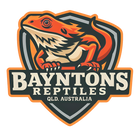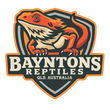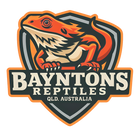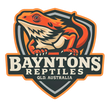Lighting & Heating Explained
Lighting and heating are critical for your dragon’s health — without proper UVB, heat, and light, dragons cannot digest food, process calcium, or stay active. Here’s everything you need to know.
🌞 UVB Lighting
Use a T5 High Output 10–12% UVB tube as the gold standard.
Position inside the enclosure, 30–40 cm above the basking spot.
Run the length of at least ⅔ of the enclosure.
Replace tube every 12 months, even if still glowing (UV output fades).
Spirals can be used, but only as a backup — they cover a smaller area.
🔥 Heat & Basking
Provide a basking spot directly under a heat lamp.
Temps (measured with digital probe):
- Babies/juveniles: 40–42 °C (104–108 °F).
- Adults: 38–40 °C (100–104 °F).
Cool side should be 25–28 °C (77–82 °F).
Night temps can safely drop to 18–20 °C (64–68 °F).
💡 Day & Night Cycle
12–14 hours of light daily.
Use a timer for consistency.
No coloured bulbs (red/blue) — dragons need bright, white daylight.
Never use heat rocks (burn risk).
📏 Lighting Placement Tips
UVB and basking heat should overlap to create a UVB + heat zone.
Dragon should be able to bask directly under both at once.
Always measure temps at basking level with a digital thermometer.
⚠️ Common Mistakes
- Using weak coil UVB only → leads to MBD.
- Placing UVB too far away (above mesh tops) → drastically reduces effectiveness.
- Heat mats or rocks → unsafe and unnecessary.
- Inconsistent day/night cycles → stresses dragons.
Final Word
Light and heat equal life for a dragon. With the right UVB and basking setup, your dragon will thrive with strong bones, good appetite, and bright colour.
🛡️ BAYNTONS REPTILES
Linebred. Legit. Legendary🐉
Common Health Issues & Prevention
Bearded dragons are hardy reptiles, but poor care or incorrect setups can quickly lead to health problems. Knowing the most common issues — and how to prevent them — is the key to keeping your dragon healthy and happy.
🦴 Metabolic Bone Disease (MBD)
Cause: Lack of UVB lighting or calcium supplementation.
Signs: Weak legs, curved spine, soft jaw, twitching.
Prevention:
- Strong UVB (T5 HO 10–12%).
- Calcium + D3 dusting for insects.
- Balanced diet with greens.
🦠 Parasites
Cause: Dirty enclosures, wild-caught feeders, poor hygiene.
Signs: Runny or smelly stools, weight loss, lethargy.
Prevention:
- Keep enclosures clean and disinfected.
- Feed only captive-bred feeders.
- Vet fecal checks if concerned.
🐍 Respiratory Infections
Cause: Incorrect temps or humidity too high.
Signs: Wheezing, bubbles at nose, lethargy.
Prevention:
- Maintain correct basking temps.
- Keep humidity around 30–40%.
- Good ventilation.
🥬 Impaction
Cause: Loose substrate (sand/wood chips), oversized feeders, low basking temps.
Signs: No bowel movement, swollen belly, dragging legs.
Prevention:
- Use safe substrates (tiles, paper, reptile carpet).
- Feed appropriate-sized insects (no bigger than space between eyes).
- Ensure proper basking temps for digestion.
🦎 Tail/Nose Rub & Shedding Issues
Cause: Rough surfaces, low humidity, stress.
Signs: Retained shed, damaged nose, stuck skin on toes/tail.
Prevention:
- Provide smooth basking areas.
- Occasional warm baths during shed.
- Keep humidity balanced (not too dry).
⚠️ Obesity
Cause: Overfeeding fatty insects, lack of exercise.
Signs: Fat pads behind head/limbs, lazy behaviour.
Prevention:
- Controlled feeding schedule.
- More greens for adults.
- Encourage movement with climbing branches and hunting feeders.
Final Word
Prevention is always easier than treatment. With correct lighting, diet, and husbandry, most common health issues can be avoided completely. A healthy dragon is an active, bright-eyed dragon.
🛡️ BAYNTONS REPTILES
Built by Bloodlines.



